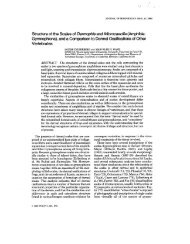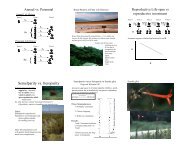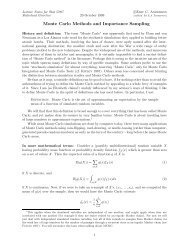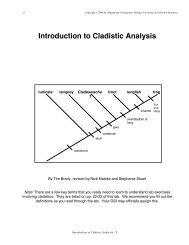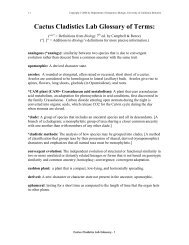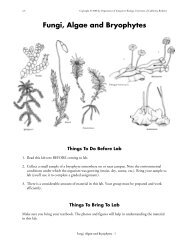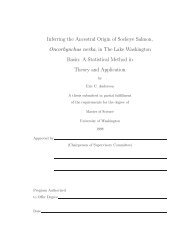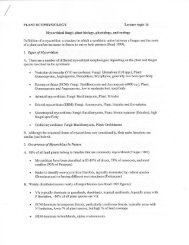Using ecological niche modeling for quantitative biogeographic ...
Using ecological niche modeling for quantitative biogeographic ...
Using ecological niche modeling for quantitative biogeographic ...
You also want an ePaper? Increase the reach of your titles
YUMPU automatically turns print PDFs into web optimized ePapers that Google loves.
594 KAITLIN C. MAGUIRE AND ALYCIA L. STIGALL<br />
Group (Condon 2005). Furthermore, the Great<br />
Plains region began to slowly uplift (Morrison<br />
1987). As the region rose, sediments in the<br />
western Great Plains were eroded and either<br />
redeposited on top of the Ogallala Group or<br />
removed completely; however, sediments<br />
accumulated in Nebraska during the Pliocene<br />
due to its northeastward slope at the time<br />
(Steven et al. 1997).<br />
Species Occurrence Data<br />
Species occurrence data were collected<br />
from the primary literature as well as online<br />
databases (Miocene Mammal Mapping Project<br />
[MIOMAP]; Carrasco et al. 2005) and the<br />
Paleobiology Database [PBDB]). Species<br />
name, geographic occurrence (latitude and<br />
longitude), and stratigraphic position were<br />
recorded <strong>for</strong> each species assigned to the<br />
subfamily Equinae (see Supplementary Material<br />
online at http://dx.doi.org/10.1666/<br />
08048.s1:). Alroy’s (2002, 2007) reidentifications<br />
of several specimens in the PBDB<br />
record were honored. The occurrence data<br />
were split into the two times slices described<br />
above. Although species occurrence data<br />
were collected <strong>for</strong> all species considered<br />
valid in recent phylogenetic hypotheses (e.g.,<br />
Hulbert 1993; Kelly 1995, 1998; Prado and<br />
Alberdi 1996; Woodburne 1996) (Fig. 1),<br />
species with fewer than five spatially<br />
distinct occurrences in the study region per<br />
time slice were excluded from the analysis.<br />
This cutoff number has been determined from<br />
<strong>modeling</strong> experiments to be the minimum<br />
data required to produce robust <strong>ecological</strong><br />
<strong>niche</strong> models using the GARP <strong>modeling</strong><br />
system (Peterson and Cohoon 1999; Stockwell<br />
and Peterson 2002). A recent revision of<br />
Cormohipparion by Woodburne (2007) was not<br />
included in this study because that revision<br />
utilized highly typological species concepts<br />
that differ from all previous analyses.<br />
Environmental Data<br />
A variety of environmental factors (e.g.,<br />
temperature, climate, vegetation, resource<br />
availability) may determine the <strong>ecological</strong><br />
<strong>niche</strong> of a horse species. Although biotic<br />
competition may have played a role in further<br />
constraining the ranges of certain species,<br />
particularly species with sympatric ranges<br />
(e.g., Calippus regulus, C. placidus, and C.<br />
martini), it is not possible to model these<br />
interactions within a paleobiologic framework<br />
or with ENM methods. This analysis,<br />
there<strong>for</strong>e, focuses on reconstructing a species’<br />
fundamental <strong>niche</strong> and not its realized <strong>niche</strong>.<br />
To model fundamental <strong>niche</strong>s of extinct<br />
species, environmental factors are estimated<br />
from sedimentological variables collected<br />
from the sedimentary record (Stigall Rode<br />
and Lieberman 2005). This study focused on<br />
five environmental parameters: percent C 4<br />
vegetation, mean annual precipitation, soil<br />
type, ecotope, and crocodilian occurrence (a<br />
temperature proxy). Each of these parameters<br />
can be determined from the sedimentary<br />
record, either through fossils or directly from<br />
sedimentary deposits. The combination of<br />
these variables produces a robust data set of<br />
environmental and climatic factors that can be<br />
used to reconstruct the distribution of horse<br />
species. The use of five environmental variables<br />
is consistent with standard ENM methodology;<br />
analyses with the GARP <strong>modeling</strong><br />
system have been successful with as few as<br />
four and as many as 19 environmental factors<br />
(e.g., Peterson and Cohoon 1999; Anderson et<br />
al. 2002; Feria and Peterson 2002). Although<br />
covariation among these environmental variables<br />
exists (e.g., ecotope and percent C 4<br />
vegetation), GARP is not sensitive to covariation<br />
among environmental variables because<br />
it is a Bayesian-based system that produces<br />
accurate results <strong>for</strong> a wide range of domains,<br />
such as numerical function optimization,<br />
adaptive control system design, and artificial<br />
intelligence tasks (Stockwell and Peters 1999).<br />
Classical and parametric statistics, on the<br />
other hand, are sensitive to covariation within<br />
data and, there<strong>for</strong>e, are not applicable <strong>for</strong> this<br />
study. The five environmental parameters are<br />
discussed individually below, and data are<br />
presented in Tables 3 and 4.<br />
Stable Carbon Isotopes.—During the Cenozoic,<br />
the dominant vegetation type shifted from<br />
enclosed <strong>for</strong>ests with leafy shrubs and trees<br />
(C3 plants) to grasslands (C4 plants). This shift<br />
in vegetation created a mosaic of food sources<br />
<strong>for</strong> equid taxa during the Miocene, promoting<br />
a diverse range of morphological feeding



